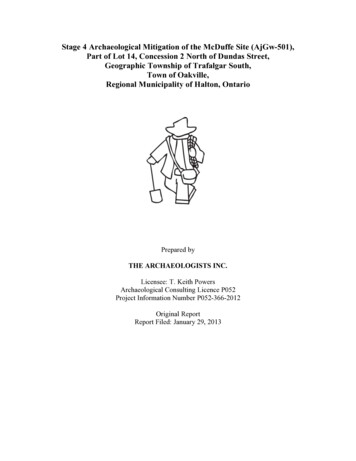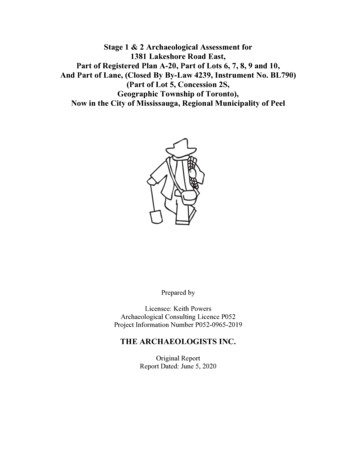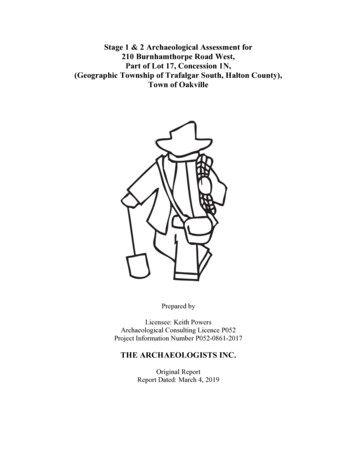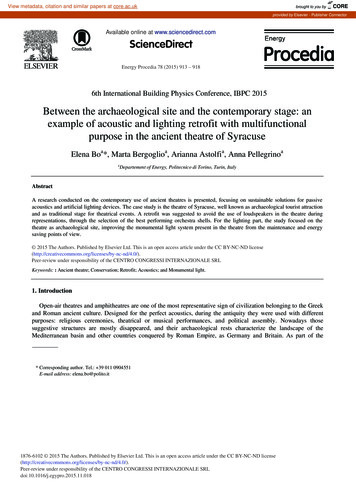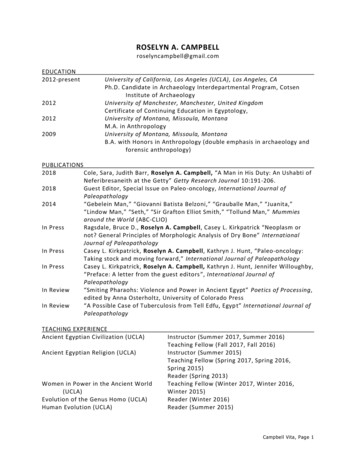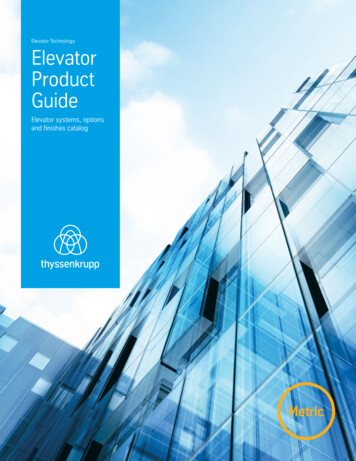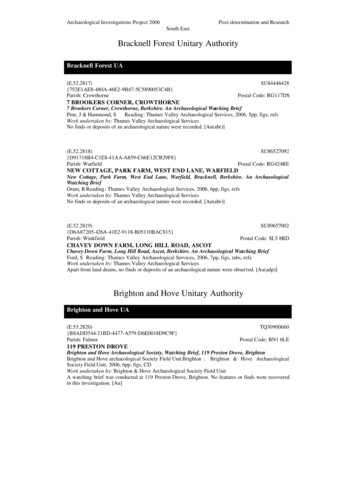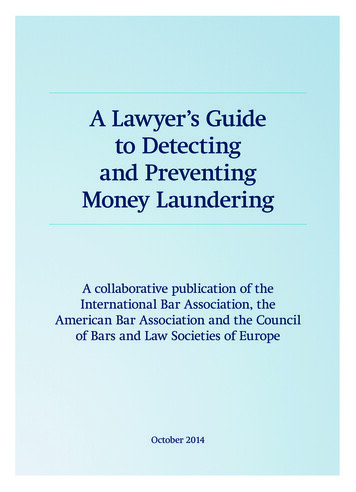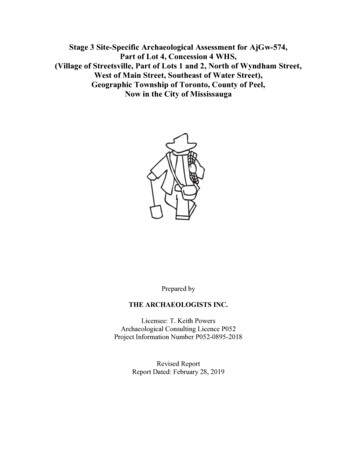
Transcription
Stage 3 Site-Specific Archaeological Assessment for AjGw-574,Part of Lot 4, Concession 4 WHS,(Village of Streetsville, Part of Lots 1 and 2, North of Wyndham Street,West of Main Street, Southeast of Water Street),Geographic Township of Toronto, County of Peel,Now in the City of MississaugaPrepared byTHE ARCHAEOLOGISTS INC.Licensee: T. Keith PowersArchaeological Consulting Licence P052Project Information Number P052-0895-2018Revised ReportReport Dated: February 28, 2019
EXECUTIVE SUMMARYThe Archaeologists Inc. was contracted to conduct Stage 3 Site-Specific ArchaeologicalAssessment for AjGw-574, Part of Lot 4, Concession 4 WHS, Geographic Township ofToronto, County of Peel, Now in the City of Mississauga. The archaeological assessmentwas triggered by the Planning Act and was prepared in advance of a submission forproposed development to the City of Mississauga.Site AjGw-574 was discovered by test pit survey during a Stage 1-2 assessment of thesubject property by Archeoworks Inc. (P029-0930-2017). The site consisted of 216Euro-Canadian artifacts recovered from ten positive test pits. The artifacts assemblageconsisted of both earlier 19th, and later, modern 20th century material, and was identifiedas a 19th century domestic site. Given that more than 20 artifacts recovered dated to aperiod of use before 1900, Site AjGw-574 was recommended for Stage 3 site-specificarchaeological assessment.The Stage 3 assessment strategy for the site was consistent with that outlined in the 2011Standards and Guidelines for Consultant Archaeologists for small post contact siteswhere it is not yet evident that the level of cultural heritage value or interest will result ina recommendation to proceed to Stage 4 mitigation. The Stage 3 assessment consisted ofthe excavation of one-metre square test units at 5 metre intervals followed by anadditional 20% of the initial grid unit total focusing on areas of interest within the site.Test unit excavation resulted in the excavation of 28 test units and the recovery of 254artifacts, which is considered a very low artifact density for a typical 19th centuryhomestead site. Also, no structural remains or features were noted, which is not typicalof a 19th century site. No midden areas or cultural features were identified. The subjectproperty contains significant amounts of disturbance, which is evident in the south part ofthe site where there is no natural soil profile, as well as in the evidence of fill foundthrough the units indicating disturbed soil. An extensive search of materials at theOntario Archives revealed a lack of any indication that structures existed on Lot 2, whereSite AjGw-574 is located. The Abstract Index to Deed Titles, Village of Streetsville, doesnot have any transactions listed for Lot 2, which appears to coincide with the fact that nostructures are illustrated on Lot 2 on either the 1859 or 1877 historic mapping. Given thelow artifact yields, lack of structural depictions on historic mapping and archival researchsupporting this, as well as the disturbance on the site, it is recommended that there are nofurther heritage concerns for Site AjGw-574.i
TABLE OF CONTENTSExecutive SummaryTable of ContentsProject Personnel1.0 Project Context1.1 Development Context1.2 Historical Context1.3 Archaeological Context2.0 Field Methods3.0 Record of Finds4.0 Analysis and Conclusions5.0 Recommendations6.0 Advice on Compliance withLegislation7.0 Bibliography and Sources8.0 Images9.0 MapsAPPENDIX Aiiiiii111681012141516182132ii
PROJECT PERSONNELProject/Field Director:Mr. T. Keith Powers (P052)Field Archaeologists:Mr. T. Keith PowersMr. Barclay PowersMr. John EllisMr. Sam FilipeMrs. Karen PowersReport Preparation:Mrs. Susan DyerMr. T. Keith PowersGraphics:Mrs. Karen PowersMr. T. Keith Powersiii
Stage 3 Site-Specific Archaeological Assessment for AjGw-574, Part of Lot 4, Concession 4 WHS,Geographic Township of Toronto, County of Peel, Now in the City of MississaugaINTRODUCTIONThe Ontario Heritage Act, R.S.O. 1990 c. O.18, requires anyone wishing to carry outarchaeological fieldwork in Ontario to have a license from the Ministry of Tourism,Culture & Sport (MTCS). All licensees are to file a report with the MTCS containingdetails of the fieldwork that has been done for each project. Following standards andguidelines set out by the MTCS is a condition of a licence to conduct archaeologicalfieldwork in Ontario. The Archaeologists Inc. confirms that this report meets ministryreport requirements as set out in the 2011 Standards and Guidelines for ConsultantArchaeologists, and is filed in fulfillment of the terms and conditions an archaeologicallicense.1.0PROJECT CONTEXT (Section 7.5.5)This section of the report will provide the context for the archaeological fieldwork,including the development context, the historical context, and the archaeological context.1.1Development Context (Section 7.5.6, Standards 1-3)Section 7.5.6, Standard 1The Archaeologists Inc. was contracted to conduct Stage 3 Site-Specific ArchaeologicalAssessment for AjGw-574, Part of Lot 4, Concession 4 WHS, Geographic Township ofToronto, County of Peel, Now in the City of Mississauga. The archaeological assessmentwas triggered by the Planning Act and was prepared in advance of a submission forproposed development to the City of Mississauga.Section 7.5.6, Standard 2There is no additional development-related information relevant to understanding thechoice of fieldwork strategy or recommendations made in the report.Section 7.5.6, Standard 3Permission to access the study area to conduct all required archaeological fieldworkactivities, including the recovery of artifacts was given by the landowner and theirrepresentative.1.2 Historical Context (Section 7.5.7, Standards 1-2)Section 7.5.7, Standard 1In advance of the Stage 3 assessment, a Stage 1 background study of the subject propertyand Stage 2 archaeological assessment was conducted by Archeoworks Inc. (2017).Characteristics indicating archaeological potential include the near-by presence ofpreviously identified archaeological sites, primary and secondary water sources, featuresindicating past water sources, accessible or inaccessible shoreline, pockets of welldrained sandy soil, distinctive land formations that might have been special or spiritualplaces, such as waterfalls, rock outcrops, caverns, mounds, and promontories and their1
Stage 3 Site-Specific Archaeological Assessment for AjGw-574, Part of Lot 4, Concession 4 WHS,Geographic Township of Toronto, County of Peel, Now in the City of Mississaugabases, resource areas, (including food or medicinal plants, scarce raw materials, earlyEuro-Canadian industry), areas of early Euro-Canadian settlement, early historicaltransportation routes, property listed on a municipal register or designated under theOntario Heritage Act or that is a federal, provincial or municipal historic landmark orsite, and property that local histories or informants have identified with possiblearchaeological sites, historical events, activities, or occupations.Archaeological potential can be determined not to be present for either the entire propertyor a part of it when the area under consideration has been subject to extensive and deepland alterations that have severely damaged the integrity of any archaeological resources.This is commonly referred to as ‘disturbed’ or ‘disturbance’, and may include: quarrying,major landscaping involving grading below topsoil, building footprints, and sewage andinfrastructure development. Archaeological potential is not removed where there isdocumented potential for deeply buried intact archaeological resources beneath landalterations, or where it cannot be clearly demonstrated through background research andproperty inspection that there has been complete and intensive disturbance of an area.Where complete disturbance cannot be demonstrated in Stage 1, it will be necessary toundertake Stage 2 assessment.The background study determined that the following features or characteristics indicatearchaeological potential for the subject property: ! There are 10 known archaeological sites within one-kilometre of the subjectproperty, ! The subject property is adjacent to two historic transportation routes according tothe 1877 Atlas (Main Street and Wyndham Street). ! The subject property is adjacent to the Credit River. ! The historic mapping indicates the presence of structures within the boundaries ofthe subject property.Summary of Land Use HistoryA summary of the land use history was detailed in the Stage 1 and 2 report byArcheoworks Inc. According to their report:Euro-Canadian Settlement Period (1800s to present)After this purchase, the land was divided into the Township of Toronto in PeelCounty and Townships of Trafalgar and Nelson in Halton County, and is knownas the “Old Survey” (Clarkson, 1977, p. 8; Riendeau, 2002, pp.123). PeelCounty was initially part of Home District, and the County of Peel was dividedinto township: the preferred unit of land division by British administrators(Loverseed, 1987, p.23). The Old Survey of the Township of Toronto wascompleted in 1806 by Samuel Wilmot, Deputy Surveyor (Walker and Miles, 1877,p.86). Dundas Street, a military road conceptualized by Lieutenant-GovernorJohn Graves Simcoe and constructed by the Queen’s Rangers following a trailused by the Natives, was the only road, and consequently the main east-westroadway through the province, that penetrated the dense forest in Toronto2
Stage 3 Site-Specific Archaeological Assessment for AjGw-574, Part of Lot 4, Concession 4 WHS,Geographic Township of Toronto, County of Peel, Now in the City of MississaugaTownship, and until settlers arrived, remained a wagon-width trail (Clarkson,1977, p.8; Riendeau, 2002, p.123). Initial settlement in the Township of Torontowas along Dundas Street and these first settlers were experienced farmers, manyof which were United Empire Loyalists and Late Loyalists (Riendeau, 2002,pp.123-124).The Napoleonic Wars in Europe had slowed immigration from the British Isle;only 175 individuals are listed in the Township of Toronto the 1809 CensusRecord (Riendeau, 2002, p.125). In June of 1812, the United States declared waron Great Britain and Upper Canada became a major battleground; however, nobattles came closer than the Humber River (Clarkson, 1977, p.9). After the warof 1812, there was mounting pressure for new land to accommodate the“increasing amount of new settlers from the British Isles, to meet the demands ofthe demobilized military personnel for their promised land grants, and to providethe necessary land for children of the United Empire Loyalists who had settled ineastern Ontario and on the Niagara Frontier a generation earlier” (McKinney,1967, p.244). To accommodate this influx of settlers, the remainder of theMississauga Tract, within what is now Peel Region, was purchased by WilliamClaus in 1818. The area belonged to the Credit River Mississauga who, despiteefforts from the Indian Department officials to protect them, found themselvesvictim to encroachment on their lands and fisheries by Euro-Canadian settlers(Surtees, 1994, p.116). The Credit River Indians (the Mississauga), under theleadership of Ajetance, chief of the Credit River Mississauga, settled for goods inthe value of 522.10 shilling annually per person in exchange for 648,000 acresof land, including some along the Credit River. This Second Purchase, known asthe Ajetance Purchase or Treaty 19, surrendered lands north of Eglinton Avenueand formed the ‘New Survey’ of the Township of Toronto (Riendeau, 2002,pp.123,127; Surtees, 1994, p.117; N.A., 1891, p.lv).In 1826, the Mississauga village at the mouth of the Credit River was relocated tothe Credit Mission, located on the site of what is now the Mississauga Golf andCountry Club on Mississauga Road (FitzGibbon, 2009; Riendeau, 2002, p.125).By 1837, the Mississauga population was decimated by contagious diseases, suchas smallpox, tuberculosis and measles (Smith, 2002, p.110; Riendeau, 2002,p.125). Due to the pressures of the agrarian way of life of the Euro-Canadiansettler, the Mississaugas of the Credit River were relocated again to the GrandRiver Reserve (Riendeau, 2002, p.125).European settlement of the Township of Toronto continued along the CreditRiver, as well as the Etobicoke River, as numerous mills were constructed alongits entirety. Streetsville, located along Mississauga Road, parallel to the CreditRiver and north of the study area, is the oldest settled village in the County ofPeel having been laid out in 1819. Timothy Street, having lived in NiagaraRegion, arrived along the Credit River when his business partner, RichardBristol, applied to undertake the survey of Toronto Township. Timothy Streetfinanced the endeavor and for his services, was granted approximately 4,5003
Stage 3 Site-Specific Archaeological Assessment for AjGw-574, Part of Lot 4, Concession 4 WHS,Geographic Township of Toronto, County of Peel, Now in the City of Mississaugaacres throughout the County of Peel and the County of Halton. This land grantincluded land along the Credit River. By 1821, a small general store opened toaccommodate the local residents and later that year, a saw mill and grist millwere constructed by Timothy Street along the Credit River. In 1823, a bridge overthe Credit River was constructed north of Dundas Street, thereby makingStreetsville a crossing and stopover village for commuters. Soon smallmanufacturing industries were constructed within the village and by 1846, thevillage contained 550 inhabitants, and had numerous factories, stores, smallmanufacturing businesses, churches for each domination and a courthouse. Thevillage continued to improve until 1858 when it was incorporated as a village(Smith, 1846, p.177; Walker and Miles, 1877, p.86; Heritage Mississauga, 2009).The village continued to thrive with the arrival of the Credit Valley Railwaythrough the village in 1879 which assisted in moving goods and people throughthe County of Peel. By the turn of the century, many of the mills located inStreetsville began to close and the village gradually changed from an industrialmill-town to a small business and service centre (Heritage Mississauga, 2009).Past Land UsePre-1900 Land UseTo further assess the study area’s potential for the recovery of historic pre-1900remains, several documents were reviewed to gain an understanding of the landuse history.The 1859 Tremaine’s Map of the County of Peel (see Map 2) depict the Village ofStreetsville to have been well established by the mid-nineteenth century. The maincommercial area was located along Queen/Mississauga Street and Main Streetand the study area if depicted within the Village of Streetsville. The 1859Tremaine’s Map – Village of Streetsville (see Map 3) depicts three residentialstructures within the study area, and numerous residential structures and a milland tannery within 300 metres of the study area. The Credit River is depictedtravelling immediately to the east of the study area.The 1877 Illustrated Atlas (see Map 4) reveals that the study area was situatedwithin the Village of Streetsville and along the Credit River. Review of the 1877Illustrated Historical Atlas of the County of Peel – Village of Streetsville (seeMap 5) depicted the study area encompassing part of village Lots 1 and 2 east ofWyndham Street and north of Main Street.Additionally, the study area is located along present-day Main Street andWyndham Street, which were originally laid out during the survey of the Villageof Streetsville. In Ontario, the 2011 S&G considers areas of early EuroCanadian settlements (e.g., pioneer homestead, isolated cabins, farmsteadcomplexes, early wharf or dock complexes, pioneer church, and early cemeteries),early transportation routes (e.g., trails, passes, roads, railways, portage routes),4
Stage 3 Site-Specific Archaeological Assessment for AjGw-574, Part of Lot 4, Concession 4 WHS,Geographic Township of Toronto, County of Peel, Now in the City of Mississaugaand properties that local histories or informants have identified with possiblearchaeological sites, historical events, activities, or occupations are consideredfeatures or characteristics that indicates archaeological potential (per Section1.3.1 of the 2011 S&G). Therefore, based on the proximity of both early EuroCanadian archaeological resources (pre-1900) within portions of the study areawhich lie within 300 metres and 100 metres, respectively, of these historicfeatures.Post-1900 Land UseTo facilitate the evaluation of the established archaeological potential, a detailedreview of aerial photographs from 1954 to 2008 and 2017 (see Maps 6-10, 12),and satellite imagery taken from 2009 (see Map 11) was undertaken.In 1954, the study area encompassed several structures fronting Main Street, atformer addresses 36, 38, 40, 44 and 46 Main Street, and manicured yardassociated with these structures (see Map 6). By 1966, the study area remainedrelatively unchanged aside from the construction of two outbuildings to the rearof 44 and 46 Main Street (see Map 7). A large structure was under constructionto the north of the study area. In 1977, the study area remained unchanged (seeMap 8).In 2002, the study area remained unchanged while three houses frontingWyndham Street had been constructed (see Map 9). By 2008, the structures at38, 40 and 44 Main Street had been razed and the following year, 46 Main Streethad been razed and the former locations for the buildings were filled with gravel(see Maps 10-11). After this time, the study area remained unchanged (see Map12).A search of material at the Ontario Archives has revealed the following informationregarding the development of Lot 4, Concession 4 WHS, Toronto Township (Lots 1 and2, North of Wyndham Street, West of Main Street, Southeast of Water Street, Village ofStreetsville).The Crown patented all 200 acres of Lot 4, Concession 4 WHS to Alexander Stewart inOctober of 1830. Alexander Stewart, in turn, sold the Lot to Timothy Street thefollowing year for 2000.00. In 1823, Timothy Street sold one acre to John Embleton for 15, which John Embleton sold two years later, in 1825, to Mary Hide for 75. From1830 to approximately 1839, it appears Timothy Street heavily sectioned off theremaining parts of the Lot and sold its many smaller pieces to multiple owners. From1839 until the end of the 19th century, the Abstract Index to Deed Titles, TorontoTownship, shows that the various sections of the Lot changed ownership many, manytimes.Further information was gathered at the Ontario Archives in the Abstract Index to Deed,Village of Streetsville. The subject property is within Lots 1 and 2, in what is described5
Stage 3 Site-Specific Archaeological Assessment for AjGw-574, Part of Lot 4, Concession 4 WHS,Geographic Township of Toronto, County of Peel, Now in the City of Mississaugain the Abstract as “North of Wyndham St., West of Main St., Southeast of Water St.”, inthe Village of Streetsville. The Abstract does not indicate any transactions for Lots 1 and2 prior to 1870 (see Figure 1).Figure 1 Abstract Index to Deed Titles, Village of Streetsville - previous to 1870.The first transaction we see for either of the two lots is in 1870, when all of Lot 1 is soldby ‘Timothy Street et al’ to James Davidson for 800. In 1871, James Davidson sells allof Lot 1 to Eliza Ann Lafleur for 325. In 1875, Eliza’s mortgage is discharged to JamesDonaldson, and in 1876, he mortgages all of Lot 1 to John McKay for 250. During thesame year, James Davidson passes away, and the Lot is willied to his wife MaryDavidson ‘et al’. In September of 1879, Lot 1 is sold from Mary Johnston ‘et al’ toThomas Ready. In 1887, the Abstract shows Edward McDonald sells all of Lot 1 toHenry Rundle (? – writing is hard to decipher) for 400, and in 1887 Henry Rundle ‘et al’mortgages the Lot to Rebecca Oliver for 200.The Abstract does not have any transaction listed for Lot 2, which appears to coincidewith the fact that no structures are illustrated on Lot 2 for either the 1859 or 1877 historicmapping.Section 7.5.7, Standard 2The fieldwork strategy for the Stage 3 assessment of the site follows therecommendations of the Stage 2 archaeological assessment report. Given the nature ofthe site, it was recommended that the Stage 3 test unit excavations follow the strategy asoutlined in Table 3.1 for small post-contact sites where it is not yet evident that the levelof cultural heritage value or interest will result in a recommendation to proceed to Stage4.6
Stage 3 Site-Specific Archaeological Assessment for AjGw-574, Part of Lot 4, Concession 4 WHS,Geographic Township of Toronto, County of Peel, Now in the City of Mississauga1.3 Archaeological Context (Section 7.5.8, Standards 1-7)In Ontario, information concerning archaeological sites is stored in the OntarioArchaeological Sites Database (O.A.S.D.), an inventory of the documentedarchaeological record in Ontario.Information on the known archaeological sites in the vicinity of the study area wasobtained form the Ministry of Tourism and Culture site database (Table 1). There are noknown archaeological sites located within the study area limits. A total of 10 sites wereregistered within a one-kilometre radius of the subject property.Table 1: Known Archaeological Sites within 1-kilometre of Subject PropertyBordenSite NameAffiliationSite TypeResearcherAjGw-115 Sheila’sOtherOtherfindspot1988, SuttonAjGw-117 BabelOtherOtherunknown ,1988,UnknownWilliamsonAjGw-118 HambaOtherOtherfindspot1988,WilliamsonAjGw-120 3 Park PointPost-Contact, PreFindspot, Homestead 1990, PearceEstates #1ContactAjGw-502 AjGw-502 – Post-ContactHouse, Scatter2009, SteissH1AjGw-503 AjGw-503 – Post-ContactHouse2009, SteissH2AjGw-574 WyndhamPost-ContactHomestead2017, SlockiH1 , KonradAjGw-67TimothyPost-ContactDistillery, Mill,1985, Mayer,Street MillTanneryPihl, Poulton &Assoc.Section 7.5.8, Standard 2The study area is situated in the South Slope physiographic region. The South Slopephysiographic region is characterized by gently rolling till plains at a height ofapproximately 245 metres above sea level, descending southward toward Lake Ontarioand ending, in some areas, at elevations below 150 metres above sea level. Numerousrivers and streams descend the Slope, having cut deep valleys in the till (Chapman andPutnam 1984:175).The subject property is located in the City of Mississauga and consists of residentialaddresses 38-46 Main Street. The property is bound on the north by residential structuresand the Credit River, on the east by the Credit River, on the south by Main Street and onthe west by Wyndham Street. The property currently consists of a woodlot, overgrownareas, an existing residential structure, asphalt and gravel driveways, manicured yardsand the Credit River floodplain.7
Stage 3 Site-Specific Archaeological Assessment for AjGw-574, Part of Lot 4, Concession 4 WHS,Geographic Township of Toronto, County of Peel, Now in the City of MississaugaSection 7.5.8, Standard 3The Stage 3 fieldwork was undertaken between June 25th and 29th. All fieldwork wasconducted following receipt of the PIF number and in favourable weather conditionsconsisting of partly cloudy to sunny skies with warm temperatures.Section 7.5.8, Standards 4 and 5Site AjGw-574 was originally identified during a Stage 1 and 2 assessment of the subjectproperty by Archeoworks Inc. (2017). The Stage 1 background study concluded that theproperty exhibits archaeological potential. A Stage 2 property assessment was conductedto document all archaeological resources on the property, to determine whether theproperty contains archaeological resources requiring further assessment, and torecommend next steps. The site was discovered during a test pit survey. A total of 216Euro-Canadian artifacts were recovered during the test pit survey. The recoveredartifacts were recovered from ten positive test pits and two test units. Both earlier 19thcentury and later, modern 20th century material was encountered. The site wasconsidered to be of further cultural heritage value and Stage 3 site-specific assessmentwas recommended for both sites.Site AjGw-574 was subject to a Stage 3 site-specific assessment by The ArchaeologistsInc. (TAI 2018) under PIF P052-0895-2018.There are no differences in the current Stage 3 work from the previously recommendedwork. The Stage 3 assessment of the site follows the relevant standards as per in Sections3.2.2 and 3.2.3 of the 2011 Standards and Guidelines for Consultant Archaeologists.Section 7.5.8, Standard 6There are no unusual physical features that may have affected fieldwork strategydecisions or the identification of artifacts or cultural features.Section 7.5.8, Standard 7There is no additional archaeological information that may be relevant to understandingthe choice of fieldwork techniques or the recommendations of this report other than thatprovided above.8
Stage 3 Site-Specific Archaeological Assessment for AjGw-574, Part of Lot 4, Concession 4 WHS,Geographic Township of Toronto, County of Peel, Now in the City of Mississauga2.0 FIELD METHODS (Section 7.9.1, Standards 1-5)This section of the report addresses Section 7.9.1 of the 2011 Standards and Guidelinesfor Consultant Archaeologists.Section 7.9.1, Standard 1All Stage 3 fieldwork was conducted according to the archaeological fieldwork standardsand guidelines as per Sections 3.2, 3.2.2, and 3.2.3 of the 2011 Standards and Guidelinesfor Consultant Archaeologists. ! Section 3.2, S1 – All relevant reports of previous fieldwork within the propertywere reviewed prior to the Stage 3 assessment. The relevant Stage 1 and 2archaeological assessment report is discussed in greater detail above. ! Section 3.2, S2 – The archaeological site assessment was conducted whenweather and lighting conditions permitted good visibility of all parts of thearchaeological site. No fieldwork was carried when weather and lightingconditions (e.g., snow cover, frozen ground, excessive rain or drought, heavy fog)reduced the ability to identify and document any part of the archaeological site.As indicated in Section 1.3 of this report, and Section 8.0, the fieldwork wasconducted in favourable weather conditions consisting of partly cloudy to sunnyskies with warm temperatures. No fieldwork was conducted in adverse conditionssuch as rain or poor visibility. ! Section 3.2, S3a&b – The Global Positioning System (GPS) was used to recordthe locations of a central fixed point within the archaeological site and apermanent datum that can be tied to a development map. The GPS readings areprovided in the supplemental documentation. GPS MAKE AND MODEL:Magellan Explorist 610 ! Section 3.2, S4 – Representative photographs of all field conditions have beenprovided in the Images section of this report. ! Section 3.2.2, S1 – Test unit excavation was conducted systematically todocument the presence and extent of buried artifacts, structures, stratigraphy andcultural features, and to collect a representative sample of artifacts, across theentire archaeological site. All test units measured 1 m square. ! Section 3.2.2, S2 – The placement of test units followed an established grid on thesite based on the permanent datum to at least the accuracy of transit and tapemeasurements. No test units were placed in unmeasured, estimated locations. ! Section 3.2.2, S3 – All test units were excavated by hand. ! Section 3.2.2, S4 – Test units were excavated by standardized systematic levels. ! Section 3.2.2, S5 – Test units were excavated into the first 5 cm of subsoil, wherepossible, unless excavation uncovered a cultural feature. No cultural featureswere noted during test unit excavation. ! Section 3.2.2, S6 – n/a ! Section 3.2.2, S7 – All excavated soils were screened through mesh with anaperture of no greater than 6mm.9
Stage 3 Site-Specific Archaeological Assessment for AjGw-574, Part of Lot 4, Concession 4 WHS,Geographic Township of Toronto, County of Peel, Now in the City of Mississauga ! Section 3.2.2, S8 – All artifacts were collected, retained, recorded and cataloguedby their corresponding grid unit or feature designation (see Appendix A). ! Section 3.2.3, S1 – The location and number of test units was determined usingstandards presented in Table 3.1 of the 2011 Standards and Guidelines forConsultant Archaeologists as well as professional judgment. The objectives of thetest unit placement strategy was to provide a uniform level of data collection fromacross the site, focus testing on key areas (as deemed appropriate based onprofessional judgment), gather a representative artifact sample from across thesite, determine the nature of subsurface deposits, and determine the extent of thearchaeological site, in order to support the recommendations for Stage 4mitigation strategies. The test unit strategy employed followed that for small postcontact sites where it is not yet evident that the level of cultural heritage value orinterest will result in a recommendation to proceed to Stage 4. We placed andexcavated 1 m square test units in a 5m grid across the site and placed andexcavated additional test units, amounting to at least 20% of the grid unit total.Section 7.9.1, Standard 2This standard is not applicable as no alternative methods acceptable through guidelines orspecial conditions was used for the Stage 3 assessment.Section 7.9.1, Standard 3GPS coordinates are provided in the supplemental documentation.Section 7.9.1, Standard 5aTest unit excavation met the applicable standards for archaeological fieldwork as perSection 3.2.2 of the 2011 Standards and Guidelines for Consultant Archaeologists, asdetailed above.Section 7.9.1, Standard 5bThe test unit grid was established in a systematic 5-metre grid pattern in relation to afixed permanent datum. The datum is locate
archaeological fieldwork in Ontario to have a license from the Ministry of Tourism, Culture & Sport (MTCS). All licensees are to file a report with the MTCS containing details of the fieldwork that has been done for each project. Following standards and guidelines set out by the MTCS is a condition of a licence to conduct archaeological
